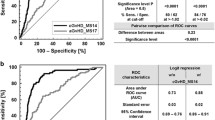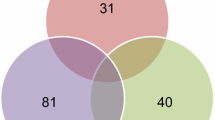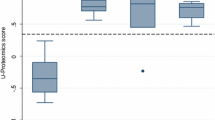Abstract
Purpose
Early diagnosis of acute rejection and effective immunosuppressive therapy lead to improvement in graft survival following kidney transplantation. In this study, we aimed to establish a urinary protein profile suitable to distinguish between patients with rejection and stable graft function and to predict acute rejection based on postoperatively collected urine samples. A further objective was to identify candidate proteins for the use as biomarkers in clinical practice.
Methods
Urine samples of 116 kidney recipients were included. Rejection was proven by biopsy (n = 58), and stable transplant function was monitored for at least 2 years (n = 58). Postoperative urine samples were collected between 3rd and 10th day following transplantation. Urinary protein profiles were obtained by surface-enhanced laser desorption/ionization time-of-flight mass spectrometry. Protein identification and validation were performed using multiplex fluorescence 2DE, peptide mass fingerprinting and enzyme-linked immunosorbent assay.
Results
A protein profile including four mass peaks differentiated acute rejection from stable transplants at the time point of rejection and at the postoperative state with 73 % sensitivity and 88 % specificity. Alpha-1-microglobulin (A1MG) and Haptoglobin (Hp) were identified as putative rejection biomarkers. Protein levels were significantly higher in postoperative urine from patients with rejection (A1MG 29.13 vs. 22.06 μg/ml, p = 0.001; Hp 628.34 vs. 248.57 ng/ml, p = 0.003). The combination of both proteins enabled the diagnosis of early rejection with 85 % sensitivity and 80 % specificity.
Conclusion
Protein profiling using mass spectrometry is suitable for noninvasive detection of rejection-specific changes following kidney transplantation. A specific protein profile enables the prediction of early acute allograft rejection in the immediate postoperative period. A1MG and Hp appear to be reliable rejection biomarkers.
Similar content being viewed by others
References
Meier-Kriesche HU, Schold JD, Kaplan B (2004) Long-term renal allograft survival: have we made significant progress or is it time to rethink our analytic and therapeutic strategies? Am J Transplant 4(8):1289–1295
Gondos A, Dohler B, Brenner H, Opelz G (2013) Kidney graft survival in Europe and the United States: strikingly different long-term outcomes. Transplantation 95(2):267–274
Tanabe K, Takahashi K, Toma H (1996) Causes of long-term graft failure in renal transplantation. World J Urol 14(4):230–235
Reichelt O, Muller J, von Eggeling F, Driesch D, Wunderlich H, Schubert J, Grone HJ, Stein G, Ott U, Junker K (2006) Prediction of renal allograft rejection by urinary protein analysis using ProteinChip Arrays (surface-enhanced laser desorption/ionization time-of-flight mass spectrometry). Urology 67(3):472–475
Li B, Hartono C, Ding R, Sharma VK, Ramaswamy R, Qian B, Serur D, Mouradian J, Schwartz JE, Suthanthiran M (2001) Noninvasive diagnosis of renal-allograft rejection by measurement of messenger RNA for perforin and granzyme B in urine. N Engl J Med 344(13):947–954
Roberti I, Reisman L (2001) Serial evaluation of cell surface markers for immune activation after acute renal allograft rejection by urine flow cytometry: correlation with clinical outcome. Transplantation 71(9):1317–1320
Bradford MM (1976) A rapid and sensitive method for the quantitation of microgram quantities of protein utilizing the principle of protein-dye binding. Anal Biochem 72:248–254
Thongboonkerd V, Chutipongtanate S, Kanlaya R (2006) Systematic evaluation of sample preparation methods for gel-based human urinary proteomics: quantity, quality, and variability. J Proteome Res 5(1):183–191. doi:10.1021/pr0502525
Neuhoff V, Arold N, Taube D, Ehrhardt W (1988) Improved staining of proteins in polyacrylamide gels including isoelectric focusing gels with clear background at nanogram sensitivity using Coomassie Brilliant Blue G-250 and R-250. Electrophoresis 9(6):255–262
Wilm M, Shevchenko A, Houthaeve T, Breit S, Schweigerer L, Fotsis T, Mann M (1996) Femtomole sequencing of proteins from polyacrylamide gels by nano-electrospray mass spectrometry. Nature 379(6564):466–469. doi:10.1038/379466a0
Hellegering J, Visser J, Kloke HJ, D’Ancona FC, Hoitsma AJ, van der Vliet JA, Warle MC (2013) Poor early graft function impairs long-term outcome in living donor kidney transplantation. World J Urol 31(4):901–906. doi:10.1007/s00345-012-0835-z
Clarke W, Silverman BC, Zhang Z, Chan DW, Klein AS, Molmenti EP (2003) Characterization of renal allograft rejection by urinary proteomic analysis. Ann Surg 237(5):660–664 discussion 664–665
O’Riordan E, Orlova TN, Mei JJ, Butt K, Chander PM, Rahman S, Mya M, Hu R, Momin J, Eng EW, Hampel DJ, Hartman B, Kretzler M, Delaney V, Goligorsky MS (2004) Bioinformatic analysis of the urine proteome of acute allograft rejection. J Am Soc Nephrol 15(12):3240–3248
Schaub S, Rush D, Wilkins J, Gibson IW, Weiler T, Sangster K, Nicolle L, Karpinski M, Jeffery J, Nickerson P (2004) Proteomic-based detection of urine proteins associated with acute renal allograft rejection. JAm Soc Nephrol 15(1):219–227
Amer H, Lieske JC, Rule AD, Kremers WK, Larson TS, Franco Palacios CR, Stegall MD, Cosio FG (2013) Urine high and low molecular weight proteins one-year post-kidney transplant: relationship to histology and graft survival. Am J Transplant 13(3):676–684. doi:10.1111/ajt.12044
Backman L, Ringden O, Dati F (1989) Serum levels of alpha-1 microglobulin in recipients of renal allografts. Transpl Int 2(1):23–26
Langlois MR, Delanghe JR (1996) Biological and clinical significance of haptoglobin polymorphism in humans. Clin Chem 42(10):1589–1600
Shen H, Song Y, Colangelo CM, Wu T, Bruce C, Scabia G, Galan A, Maffei M, Goldstein DR (2012) Haptoglobin activates innate immunity to enhance acute transplant rejection in mice. J Clin Investig 122(1):383–387. doi:10.1172/JCI58344
Hemmingsen L, Jensen H, Skaarup P, Tetsche KI, Wallin AL (1976) The predictive value of specific protein clearances in detecting acute rejection episodes after renal transplantation. Clin Nephrol 5(4):163–170
Acknowledgments
We like to thank Ms. Maria Pötsch for conducting MALDI-TOF-MS analysis and Mr. Saiful Miah for critical reading of this manuscript.
Conflict of interest
The authors declare that they have no conflict of interest.
Ethical standard
The ethical approval was obtained from the Ethics Committee of the Medical Faculty of the University Jena. Samples were obtained with written consent.
Author information
Authors and Affiliations
Corresponding author
Additional information
Beatrice Stubendorff and Stephanie Finke have contributed equally to this work.
Rights and permissions
About this article
Cite this article
Stubendorff, B., Finke, S., Walter, M. et al. Urine protein profiling identified alpha-1-microglobulin and haptoglobin as biomarkers for early diagnosis of acute allograft rejection following kidney transplantation. World J Urol 32, 1619–1624 (2014). https://doi.org/10.1007/s00345-014-1263-z
Received:
Accepted:
Published:
Issue Date:
DOI: https://doi.org/10.1007/s00345-014-1263-z




